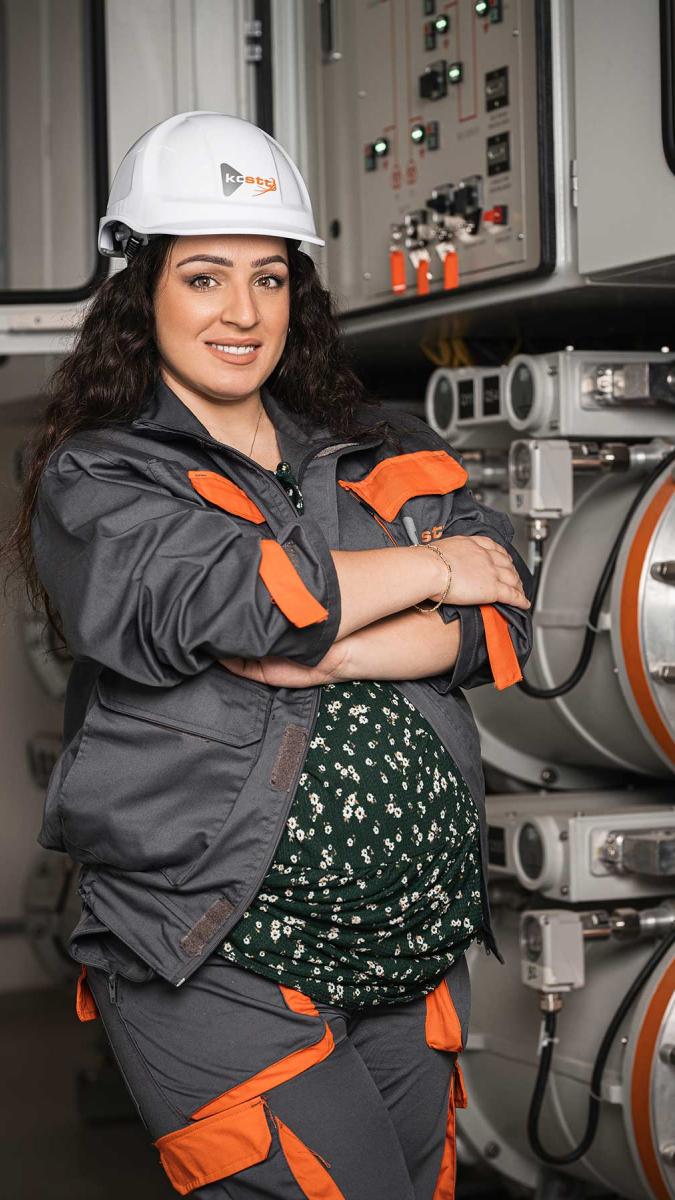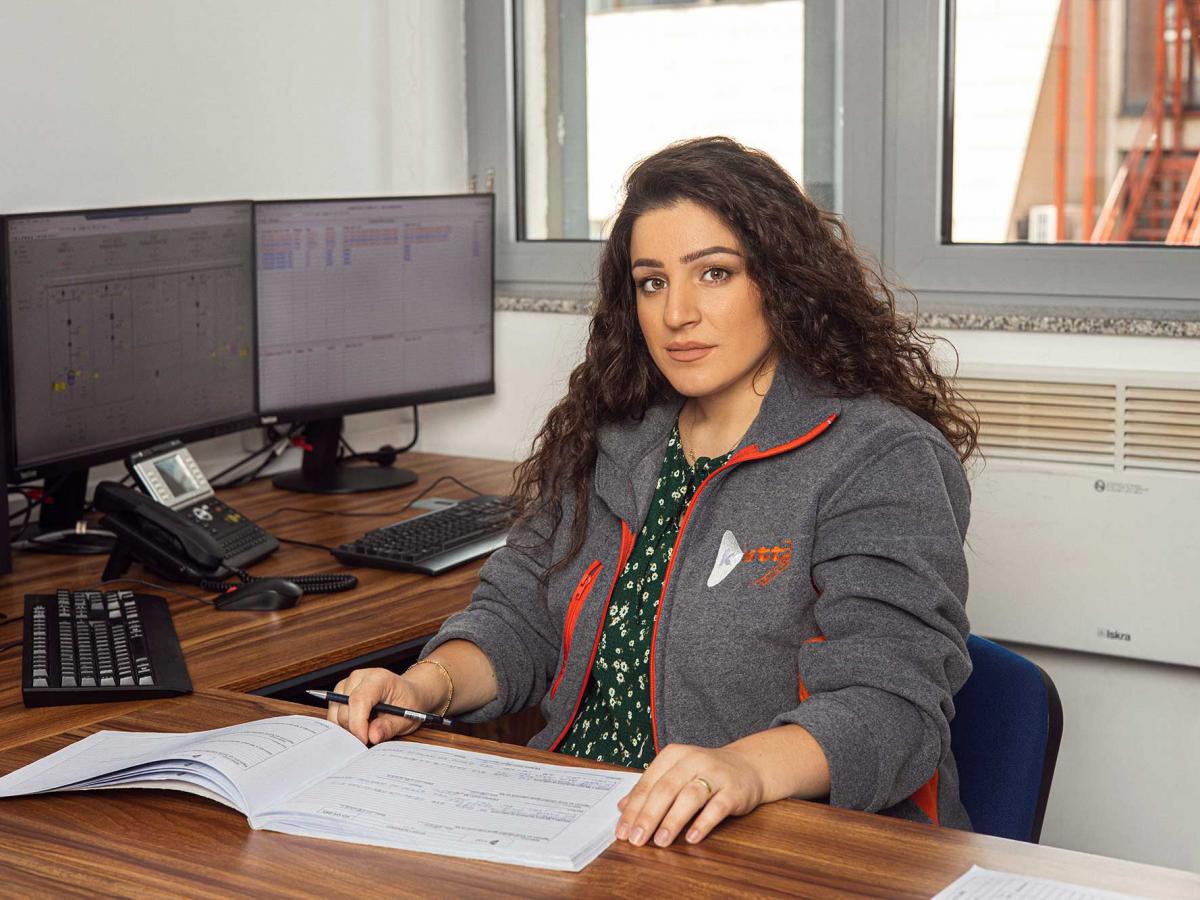First Transmitter
Dorentina Shala is the first woman to work in a power station at KOSTT
Cinderblock homes press to the edge of the road in Prugovc, where farmers display crates of tomatoes and peppers to passing traffic. Here the rhythms of life follow rural traditions: families harvest with the seasons, villagers marry outside the village, and women do not hold formal jobs.
Dorentina Shala came from a poor family and saw a different path for herself. Longing to support her family as an earner, she visualized economic independence as an adult. She took odd jobs in the village, and later enrolled in a technical school with the hopes it might lead to bigger opportunities.
“My family supported me. My father said, ‘anything the boys can do, you can do too,’” she said.
In 2019 Dorentina was scrolling through Facebook when she landed on a job ad for a technical position at KOSTT, Kosovo’s power transmission utility. Clicking on the company’s page she saw photos of women doing technical work alongside four life changing words: Women encouraged to apply.
“I never thought women could work for a company like KOSTT, but I thought, might as well try.”
Changing Tides at KOSTT
Hiring women into technical roles wasn’t always a priority for KOSTT. In fact, traditional gender norms and stereotypes created strong barriers to entry for women at the company.
“Let me explain how it was,” said Arjeta Gashi, Manager of Administration at KOSTT. “Even female directors at KOSTT didn’t believe women could perform technical roles, lift loads, or torque wrenches.”
That changed when the company enrolled in USAID’s Engendering Industries program in 2019. Working closely with a change management coach from the program, KOSTT gathered data about gender equality at the company and reviewed global research on the correlation between improved gender equality and profitability.
Leadership soon understood how profit and revenue increases could shift the trajectory of KOSTT, and stimulate Kosovo’s economy by bringing more of the 85% of women who are unemployed in the country into the workforce. The business case enabled KOSTT to sell the need for gender equality initiatives to employees internally.
“When we first started working to advance gender equality, there was resistance at all levels of the company,” Arjeta explained. “But when staff learned how profitability improves at companies with more women, that began to change.”
Primary TextAt first the goal of hiring more technical women felt abstract,” Arjeta remembered.
“We didn’t think women wanted to work in technical roles because there were no female applicants for our ads.”

Using a framework of best practices to advance gender equality, KOSTT developed a roadmap and adopted a stepwise approach for sourcing female talent, hiring and retaining more women, and employing more women in technical and leadership roles.
“At first the goal of hiring more technical women felt abstract,” Arjeta remembered. “We didn’t think women wanted to work in technical roles because there were no female applicants for our ads.”
Arjeta lobbied the CEO to make tweaks to their external communication—like adding photos of women to the website and rewriting job ads to be more inclusive of women—under program advice that showcasing KOSTT as a female-friendly workplace would open the door for more female applicants.
She was right. The move increased female applicants for open positions at the company by 20%. According to Dorentina, the strategy worked.
Becoming the First Woman
When KOSTT invited Dorentina for an interview, she thought it was a gimmick.
“I come from a village where only 10% of women work, and those that do work in bakeries and local shops,” she said. “I didn’t think KOSTT would actually hire me, but when I arrived and saw two other women sitting in the waiting room, I thought they might be serious.”
Mere days after her interview, Dorentina made history as the first woman ever to be hired by KOSTT to work at a transmission station. It was a watershed moment for both Dorentina and KOSTT. When Dorentina was hired only 17% of KOSTT’s employees were female, and only two women worked in technical roles.

Primary TextAs a working woman, I feel strong,” Dorentina said. “I want other women to apply to jobs like mine. I have learned a lot, which has pushed me to go and ask for more in our country.”
A Woman Among Men
For more than 30 years, the men in the Klima substation clocked in for their daily systems checks, familiar with every nook and wire. They knew how to respond to a power outage, head-off a gas leak disaster, and anticipate the impact of weather on power demands. They were prepared for all eventualities, except having to work with a woman.
“They didn’t think I would last long,” Dorentina remembered. “They said, ‘We’ll help you, but this work is not for you.’ And everyone in the village was talking about me. ‘How dare you,’ they told my parents.”
But Dorentina was determined. With her newly acquired drivers license she sped along Prugovc’s snowy country roads with thrill and terror, driving the hour commute to work. Her neighbors in the village were galled that a women should drive herself so far and spend her days working with men. Between the pressures of the job and the pressures of her village, Dorentina wondered each day if she should return to work the following morning. In time, attitudes about her choices began to change.
“At work I was doing everything the men taught me, and soon they said, ‘Oh, maybe you can do it,’” she said. “Then they started saying, ‘Ok, let’s push our daughters to go to a technical high school and maybe they can do it too,’” Dorentina said.
Change also took hold in Dorentina’s village. As it became clear that she was succeeding, village gossip and anger morphed into whispers of small town pride. “I became a symbol in my village of what a girl can achieve,” she said.
Slow and Steady Change
Engendering Industries has supported KOSTT to increase female employment by 10%, and in 2021, 100% of the company’s new hires were women who were recruited into technical roles.
After training for seven months at the Klima substation, Dorentina was transferred to a post in Prestina. She starts every shift with a thorough technical inspection, studying the logbook for anomalies, checking equipment temperatures, measuring for gas leaks, making repairs. After her transfer, she got married and learned she was pregnant, busting the myth that working in a substation would make a woman infertile.
“As a working woman, I feel strong,” Dorentina said. “I want other women to apply to jobs like mine. I have learned a lot, which has pushed me to go and ask for more in our country. There are so many girls in my village talking about me. They are thinking that if I can do this then they can too. I say to them all, try, try, and try again.”

Photos by Genc Fona/USAID

